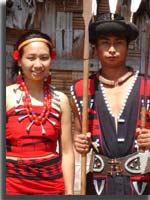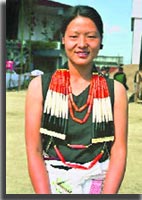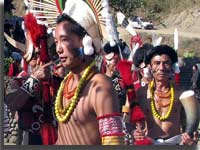History :
Angami tribe belongs to the state of Nagaland which is the extreme north eastern part of the country. Nagaland has 20 tribes and Angami is one of them. The total population of the Angamis is around 12 million. The Angamis Tribes territory is the present district of Kohima district which is divided into four regions, in the South- Angamis are located at the foothills of Mt Japfu, Western Angami are in the west of Kohima, in North -Angamis are located in the north of Kohima and Chakhro Angami including mostly small villages around Dimapur district.
Culture
Angamis are popular for their woodcraft and artwork all over India. People in India know them as the producer of bamboo work, cane furniture, beds, shawls and powerful machetes. They are very much fond of music and play great music with the help of drum and flute, which is passed on from one generation to the other. The simple and rythmic music plays the important role in their rituals and festivals. Traditional dancing is the main component in Angami gennas.

Occupation
Agriculture is the main occupation of Angami Tribe. Their cultivation includes rice and grains on the hilly terrains. They are predominantly agriculturists and can produce nearly twenty varieties of paddy crops every year. They also cultivate rice and grains on hilly terrains. The angamis, known for their environmental consciousness, use their water courses for terraced wet rice cultivation. One of the unique feature of their cultivation is that Angami Tribes carry on the cultivation with the wet rice on the hilly terrains, due to which the irrigational system has transformed the steep barren hills into picturesque rice fields.
Place /Location (then and now) |
Nagaland |
Population |
12 million |
Languages spoken |
Gnamei, Ngami, Tsoghami, and Monr. |
Religion/God |
Christianity |
Food |
Pork, Bamboo shoots |
People
Both men and women enjoy wearing beautiful ornaments like Beads, miniature mask pendants, bangles and bracelets. Pork with bamboo shoots is the common diet of the Angamis.
Language
Angamis speak Tenyidie which is the most common language among them. Angamis mother tongue is Angami Language and is identified with different names such as Gnamei, Ngami, Tsoghami, and Monr.
Festivals

The Thekra Hie is the main attraction of this festival, where the young ones of the village gather to sing and dance to the tunes of the traditional music. They make fun and enjoy themselves with the rice beer and plates of meat. Hunting is the another important excitement of the festival. The major part of the ceremony falls on the eighth day when the gate pulling or the bride pulling is performed


